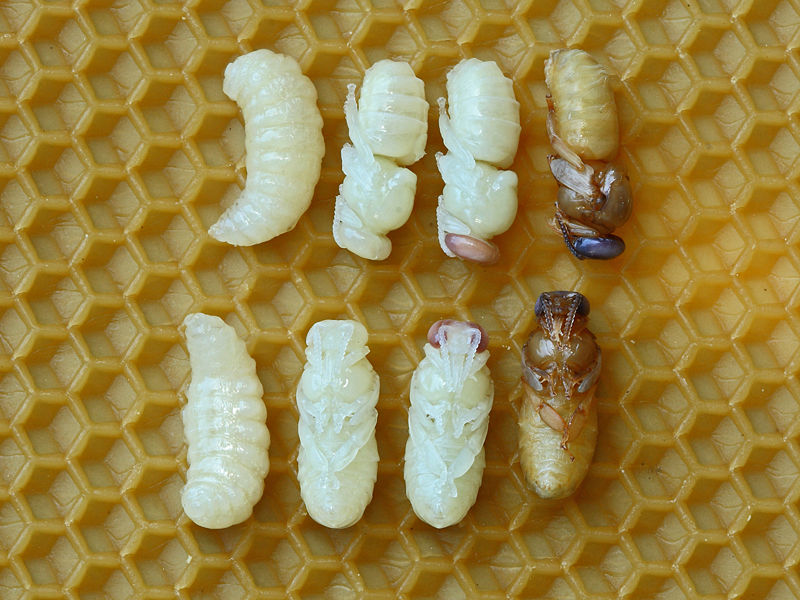Hive Mystery, Follow-Up.

Today, Robb and I opened up the Gloriana hive. We had two objectives. First, to check up on the mysterious cup-structures that the bees had built a few weeks back. (Remember that? You can click here to read about them.)
Second, we wanted to see how the bees needed more room. We had another hive box that we could add, if necessary.

As soon as we opened up the hive, we could see that the bees were building comb all over the place. They were building on tops of the frames, and also bridging between frames. Although we intend to have a fairly hands-off approach to managing our the hives, this kind of comb causes problems, because if the frames get stuck together, they'll rip apart when the frames are moved.

This can be pretty destructive, and also disgusting, if you're grossed out by larvae (the white grub in the photo, above). When this particular comb tore apart, both larvae and pupae were ripped out of their protective cells.

Developing bee pupae are interesting, in an ooky sort of way. This one looks to be about sixteen days old, judging by the fact that the eyes have colored up. I believe that the ropey-looking structure near the dark eyes are developing antennae.

This is a photo I yanked off of Wikipedia, showing the metamorphosis of the larva into the pupa. The heads are in the center of the photograph. The top row shows a profile view, while the lower row shows the bee face-on.
I'll be honest and say that before we started keeping bees, I was way more worried about my reaction to larvae and pupae than I was about bee-stings. I'm pretty tough, but I have no love of maggots and their ilk.
Of course, all that larvae and pupae are part of the bee's life cycle, and a beekeeper can't bee too squeamish. Thankfully, the developing bees don't move around. If they squirmed, that would be a deal breaker, and I'd never be able to keep bees.

So, now that we're all suitably grossed-out by the life cycle of the bee, let's get back to business.
Back when we first found what we thought were swarm cells, I wrote to every one of my online beekeeper heroes. There are a number of people, keeping bees, following organic practices, and documenting their efforts online. I wrote to all of them.* And remarkably, they all wrote back.
The consensus was "don't worry."
My queen was surely too young to be about to swarm. And what I thought were swarm cells, were more likely "queen cups" which the bees build as a sort of insurance, in case they need to raise another queen.

Robb and I had already checked on the cups last weekend, because when we found them I didn't have the good sense to see if the cups contained developing larvae. (They didn't.)
We wanted to see if anything had changed since we last looked. As it turned out, the bees were still building queen cups, and had constructed this particularly eccentric bit of comb.
Do you see the two cups in the photo, above? They are described as looking like peanut shells, and I think that's fairly apt, in terms of the size and texture.

Here's another one of these cups. The bees don't merely build uniform slabs of what we'd call honey-comb. Their structures are far more complex than I had imagined, when we first started researching beekeeping.

So, the question about the status of the mysterious cups was answered. ("Don't panic.")
What was the answer to the other question? Did the bees have enough room, or did we need to add another hive box? Well, two weeks ago, the bottom box of our hive was only partially in use. The bees had only built comb on half of the frames, and that comb was fairly incomplete.
As of today, every single frame but this one was almost completed. The bees were going to need more space.

Even after we removed this frame from the hive box, the bees continued "festooning" or clinging together. This is the first step in the construction of new wax comb, although as I type that I realize I don't understand how hanging on to each other advances the building process.
We were pleased that the bees were building a lot of comb, and that the queen was laying tons of eggs. We saw several baby bees emerging into the world by chewing their way out of their protective wax cells (the photos aren't worth sharing -- maybe next time). I'm sure the bees will make good use of the new hive box we've given them.
* If you're interested in reading some of the aforementioned beekeepers' websites or blogs, click on their names. Not everyone I asked for help has a web presence.

Comments
From the looks of it, the bees have been inspired by Gaudi- maybe a Sagrada de la Familia hive is in your future?
I've heard that most bees can't sting. But who knows.
Maybe take a hard look at their eyes, to see if they're actually bees, or just bee mimicking hover flies. We had a flock or herd or gaggle of those in our old apartment. Heyd just fly in a cluster in the living room. There are as many bee mimicks as there are bees. Ands that's not even considering wasps.
http://www.facebook.com/album.php?aid=2040466&id=1105946845&saved#!/photo.php?pid=30723648&id=1105946845
http://www.facebook.com/album.php?aid=2040466&id=1105946845&saved#!/photo.php?pid=30723649&id=1105946845&fbid=1312635771737
I'll try out the places you suggested too.
Thanks you.
HEather
--greg
Greg -- I've heard that theory, but I'm not sure how it would work in practice. "Hang on! Hang on! I've just about secreted enough wax!"